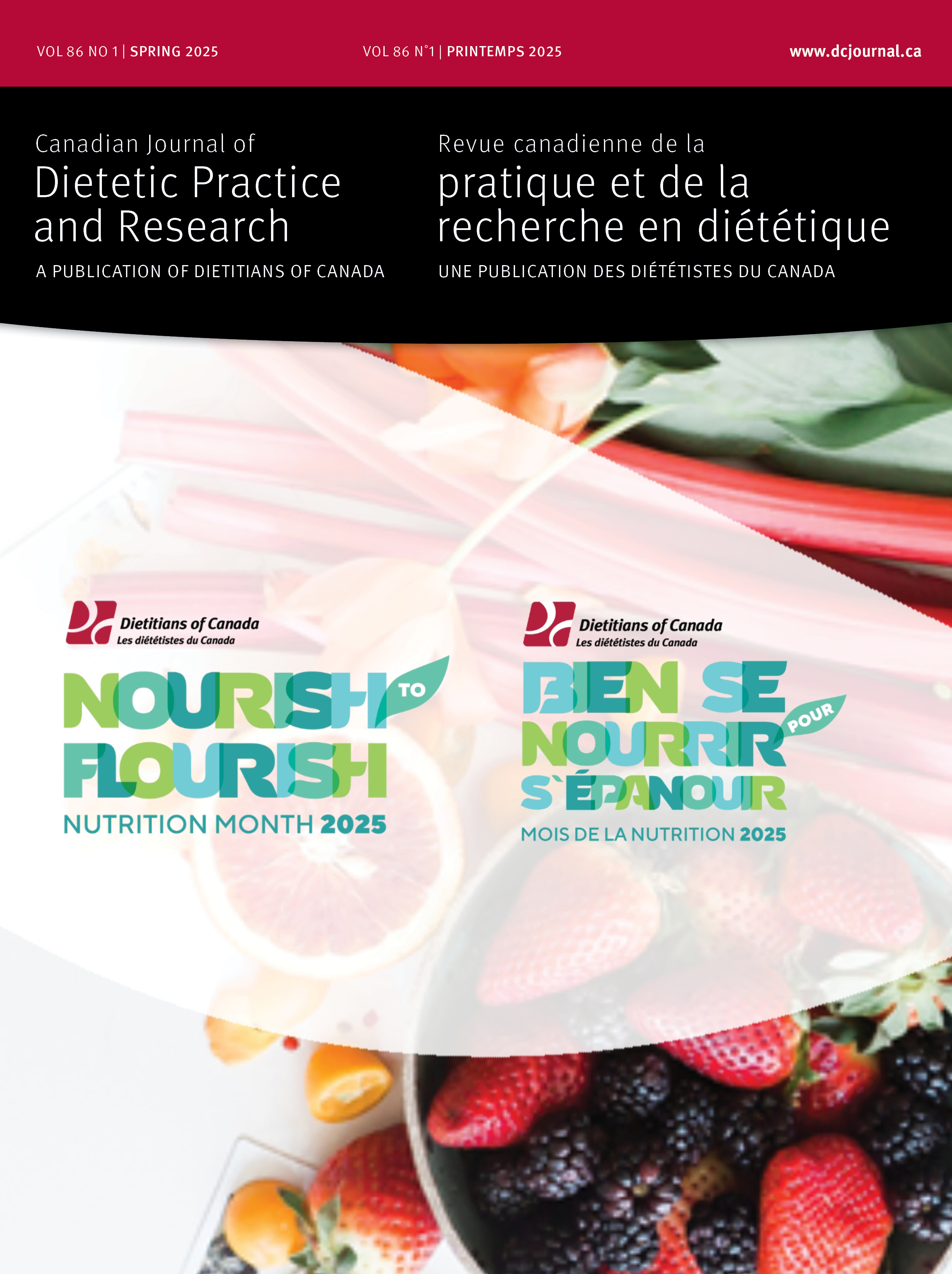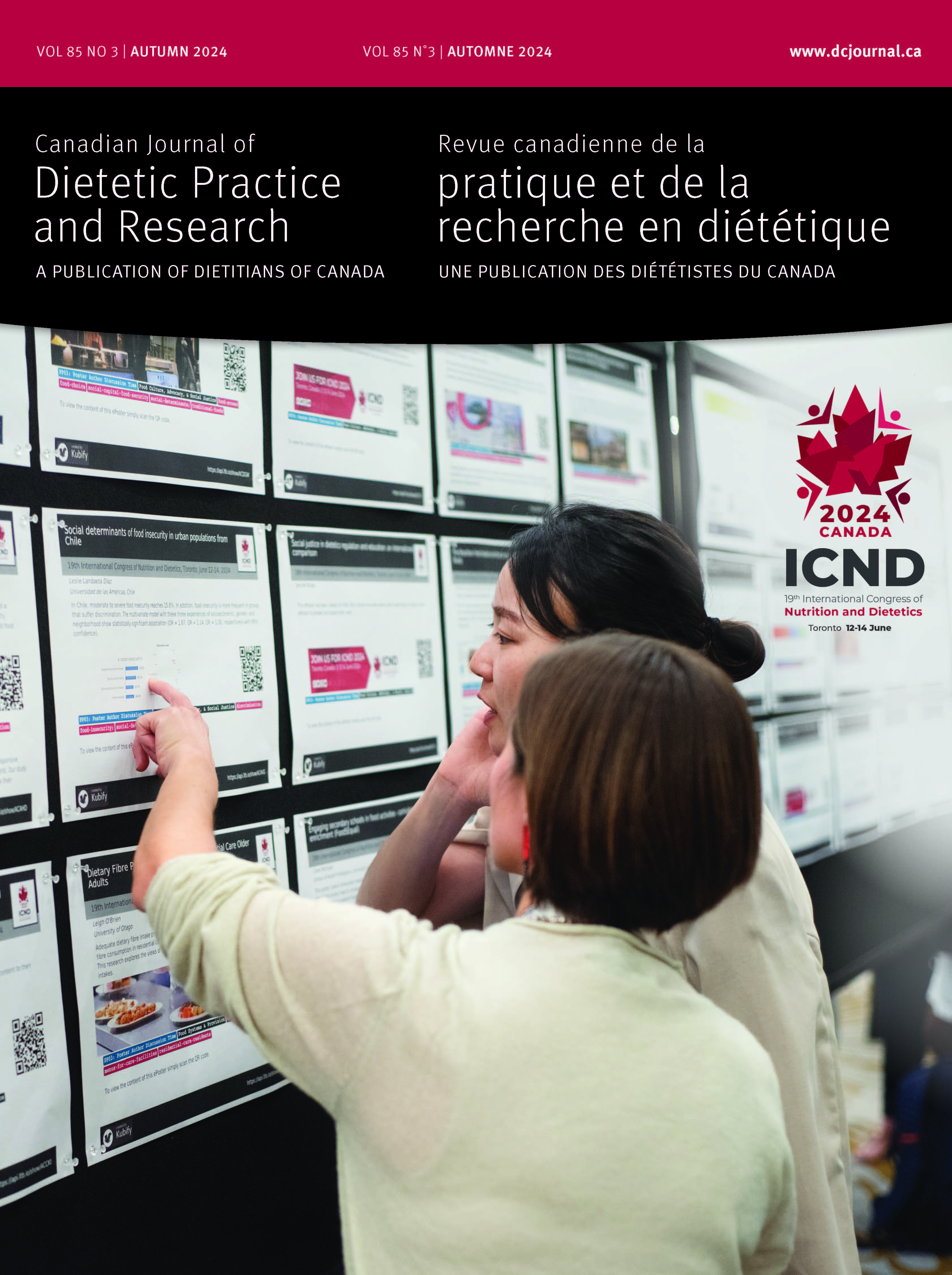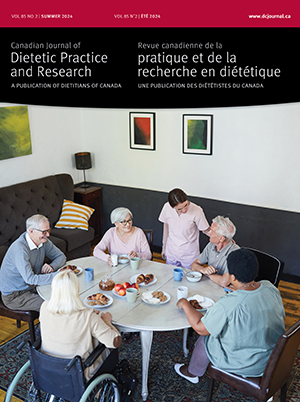Volume 66 • Number 4 • December 2005
Chair’s Message
Editor’s Message
Research
Purpose: The literature suggests that adherence to dietary recommendations may differ between women and men with type 2 diabetes due to family obligations and spousal support. Methods: To assess division of household labour between spouses, retrospective chart review of 561 individuals who attended the Diabetes Education Centre at the Toronto Western Hospital was performed. Qualitative interviews were also performed with 12 married clients (six female and six male) and seven spouses of clients (three female, four male) to understand how the sharing of household labour influences adherence to nutrition guidelines in type 2 diabetes. Results: Results indicate a significant gender difference in responsibility for meal preparation (χ2(3)=140.64, p<.001) and grocery shopping (χ2(3)=88.24, p<0.001), with women more often engaging in these household activities than men. Male clients are more likely to be actively supported by their wives in the form of meal preparation and verbal encouragement, while female clients are only passively supported by their husbands. Conclusions: The results suggest that diabetes educators should recognize gender differences in household labour and support when counselling their clients to ensure that both men and women have the help they need to successfully manage their diabetes.
Purpose: This study determined dietetics trainees’ and program coordinators’ perceptions about trainees’ preparedness to practice, based on Dietitians of Canada’s 145 competency statements. Depth and breadth of learning opportunity were also determined with definitions of these two concepts based on Elliott’s view of professional education and practice. Methods: Research questions were: 1. How prepared were trainees for practice? 2. What were the depth and breadth of learning opportunity in assessment, planning, implementation and evaluation? 3. How many learning opportunities were there in professional practice and communication? 4. Did responses vary between integrated programs and internships or between trainees and program coordinators? Results: Of 313 trainees, 168 (54%) responded and 23 (72%) of 32 coordinators responded. Preparedness was rated as “well prepared” or better for 25 (56%) of the 45 main competencies. For every competency, preparedness ratings were higher in integrated programs than in internships. Learning opportunities were rated as sufficient in depth and breadth or number for 88 (61%) of the 145 competency statements. Low ratings for preparedness were accompanied by low ratings for depth and/or breadth or number of learning opportunities. Conclusions: The notion of depth and breadth is useful as a framework to assess learning opportunities for developing entry-level competence.
Purpose: Canada’s multicultural population poses challenges for culturally competent nutrition research and practice. In this qualitative study, the cultural relevance of a widely used semiquantitative fruit and vegetable food frequency questionnaire (FFQ) was examined among convenience samples of adults from Toronto’s Cantonese-, Mandarin-, Portuguese-, and Vietnamesespeaking communities. Methods: Eighty-nine participants were recruited through community-based organizations, programs, and advertisements to participate in semi-structured interviews moderated in their native language. Data from the interviews were translated into English and transcribed for analysis using the constant comparative approach. Results: Four main themes emerged from the analysis: the cultural relevance of the foods listed on the FFQ, words with multiple meanings, the need for culturally appropriate portionsize prompts, and the telephone survey as a Western concept. Conclusions: This research highlights the importance of investing resources to develop culturally relevant dietary assessment tools that ensure dietary assessment accuracy and, more important, reduce ethnocentric biases in food and nutrition research and practice. The transferability of findings must be established through further research.
Purpose: In this study, the Dietary Reference Intake standards were used to evaluate the prevalence of inadequate intakes of micronutrients in obese and non-obese youth. Methods: Dietary intake was analyzed with a dietary history taken by a registered dietitian. The obese group (n=156) had a body mass index (BMI) above the 95th percentile for age and sex. The non-obese group (n=90) was between the tenth and 85th BMI percentiles. Results: In the obese subjects, the prevalence of inadequate intakes was 81% for vitamin E and 27% for magnesium; the proportions with intakes below the Adequate Intakes (AIs) for calcium and vitamin D were 55% and 46%, respectively. The obese children consumed 124% of estimated need for energy, 32% of which came from fat. The non-obese had a similar prevalence of inadequate intakes (vitamin E, 93%; magnesium, 29%; calcium, 51%; vitamin D, 44%). They consumed 107% of estimated need for energy, and 31% of energy came from fat. For both groups, all other nutrient intakes were adequate. Conclusions: Even though children may consume an excess of energy, they may not be meeting all of their micronutrient needs.
Review
Purpose: Collective kitchens are community-based cooking programs in which small groups of people cook large quantities of food. They have developed over the past 20 years, and hundreds of groups have been formed across the country. However, collective kitchens described in the literature vary considerably in structure, purpose, and format. The purpose of this review is to synthesize research on this topic. Methods: Articles and theses were collected through searches of major databases, and synthesized to improve understanding of current information, and of continuing gaps in the knowledge of collective kitchens in Canada. Results: The limited published research on collective kitchens suggests that social and learning benefits are associated with participation. Some indication exists that participants also find the food cooked to be high quality, culturally acceptable, and acquired in a manner that maintains personal dignity. Whether collective kitchens have an impact on food resources as a whole is unclear, as research has been limited in scale. Conclusions: The role of collective kitchens in community building and empowering participants often is noted, and bears further investigation. Dietitians and nutritionists have a unique opportunity to facilitate the health promotion and food security benefits of collective kitchens.
Report
Purpose: Modifications to the amount and type of fat in the diet are recommended as strategies to help reduce heart disease risk. Individuals can choose from a variety of margarines and oils to alter their intakes of different types of fats, and nutrient content claims on product labels (e.g., ‘low in saturated fat’) can help them quickly identify healthful products. However, margarines and oils vary in price. Methods: To examine the relationship between the price and amounts of saturated and trans fats in margarines and oils, and the relationship between price and the presence of nutrient content claims, price and label information were recorded for margarines (n=229) and oils (n=342) sold in the major supermarkets within the Greater Toronto Area. Results: Linear regression analysis revealed a negative relationship between the price and amounts of saturated fat and trans fats in margarines, but not in oils. Margarines with a nutrient content claim were significantly more expensive than were those without a claim. Conclusions: The findings for margarines are of particular concern for lower income groups for whom budgetary constraints result in the purchase of lower priced foods, and also raise important questions about the usefulness of nutrient content claims in guiding food selections.
Purpose: Food avoidance is central to the treatment of environmental sensitivity (ES), a chronic, often debilitating, multisystem disorder characterized by adverse reactions to non-noxious levels of environmental substances. Because prolonged food avoidance could impact nutritional health, the purpose of this research was to assess adequacy and quality of diets consumed by women diagnosed with ES. Methods: Twelve women aged 37 to 50 recruited from the Nova Scotia Environmental Health Clinic completed a fourday food record during the spring and summer of 1998. Results: When adequacy of nutrient intake was assessed by comparison to the Estimated Average Requirement, the most limited nutrients in the diet were folate, vitamin B6, vitamin B12, and magnesium. Only one woman exceeded the Adequate Intake for calcium. When diet quality was assessed using the Healthy Eating Index, the majority of women (75%) scored in the “needs improvement” category; intake of milk and dietary variety scored the lowest. Women consumed very few servings from “other foods”, defined in the food guide as foods containing mostly sugar and mostly fat. Conclusions: The results of this study suggest that women diagnosed with ES would benefit from counselling on ways to increase dietary variety, which would lead to improved nutrient intake, and ways to increase calcium intake.










